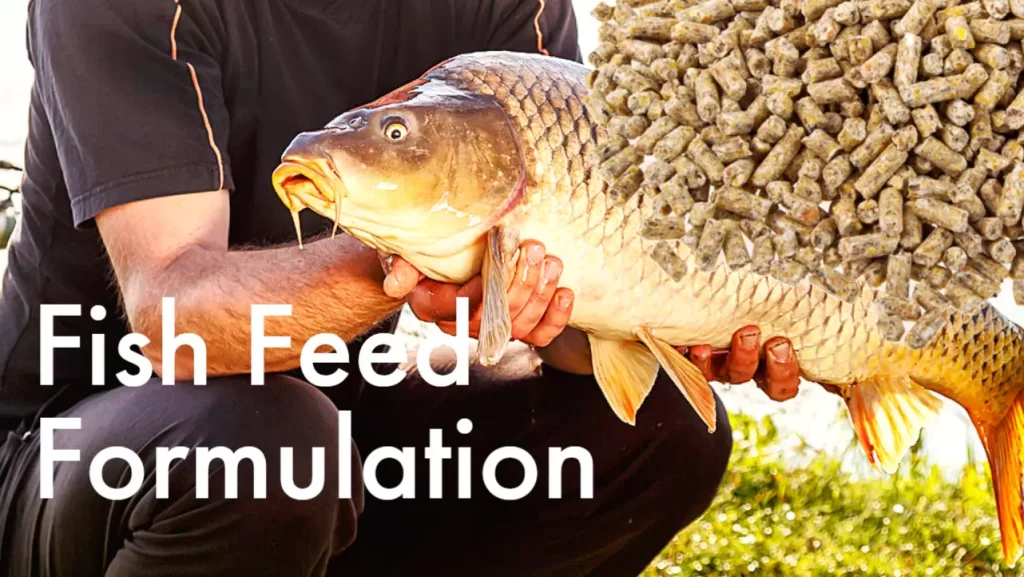Fish feed formulation is an important issue for making fish feeds. Most of the fish farms now understand the need to make fish feed. Many entrepreneurs want to make fish feed. This fish feed formulation will be useful for all those farms and entrepreneurs.
Table of Contents
Fish feed quality
There are two qualities of feed to use in fish farming.
- Floating fish feed
- Sinking fish feed
Feed types
There are many types of fish ere rearing in pond or tank. We are showing most of the farmed fish feed formulation here.
- Pangasius fish feed
- Shrimp feed
- Pabda fish feed
- Carp fish feed
Fish feed formulation
Fish feed is not difficult for making on-farms or houses. But you must have proper knowledge about making feeds.
Carp feed fourmulation
Carp fish eats aquatic phytoplankton and zooplankton in ponds. Carp fish also takes concentrate feed. The Carp fish diet requires 24-25% protein, 4-5% fat, and 3000 kcal/kg energy. Below is a carp fish feed formulation
| Feed Ingredients | Quantity (kg) |
| Reich Bran | 30 |
| DORB (Deoiled Rice Bran) | 30 |
| Soybean meal | 30 |
| Fish Meal | 5 |
| Molasses | 2 |
| Salt | 1.5 |
| Limestone | 1 |
| Dicalcium phosphate | 0.300 |
| Fish Premix (Vitamins & Minerals) | 0.200 |
Pangasius fish feed formulation
Pangasius feed should contain 28-30% protein, 5-6% fat, and 3300 kcal/kg energy. A formulation is below.
| Feed Ingredients | Quantity (kg) |
| Reich Bran (Auto Mill) | 25 |
| DORB | 25 |
| Soybean meal | 35 |
| Fish Meal | 10 |
| Molasses | 2 |
| Salt | 1.5 |
| Limestone | 1 |
| Dicalcium phosphate | 0.300 |
| Fish Premix (Vitamins & Minerals) | 0.200 |
Tilapia feed fourmulation
Tilapia fish feed should contain 28-30% protein, 6-8% fat, and 3350 kcal/kg energy. A formulation is below.
| Feed Ingredients | Quantity (kg) |
| Reich Bran (Auto Mill) | 25 |
| DORB | 25 |
| Soybean meal | 35 |
| Fat/Oil | 0.5 |
| Fish Meal | 11 |
| Molasses | 2 |
| Salt | 1.5 |
| Limestone | 1 |
| Dicalcium phosphate | 0.300 |
| Fish Premix (Vitamins & Minerals) | 0.200 |
Feed manufacturing prosses
Things to keep in mind when preparing fish feed:
- Feed prices should be relatively low.
- The quality of feed must be maintained properly.
- The quality of feed ingredients should be good.
- Must be air tight packaged with liner or polybag.
- Feed grade medicine should be used to prevent fungus in the feed.
- Care should be taken to ensure that the feed is easy to digest and safe for fish.
- No hormones or antibiotics can be used.
Read this: Poultry Feed Formulation And Making
Thanks for visiting us and reading this full article, We hope this helped you a bit to know about fish feed formulation. Be back again, thanks. Please leave a comment in the following.


want to make feed
good day
I am interested in farming basa fish
stay on a small holding
regards Norman Andrew’s
This article provides valuable insights into fish feed formulation, which is undoubtedly a crucial aspect of fish farming. It’s heartening to see that the author acknowledges the growing awareness among fish farms and entrepreneurs regarding the importance of making high-quality fish feed.
The categorization of fish feed into floating and sinking types is a practical approach, considering the diverse needs of different fish species and farming setups. Additionally, listing various types of farmed fish and their respective feed formulations adds depth to the article, making it a useful reference for fish farmers.
The detailed breakdown of feed formulation for carp, pangasius, and tilapia is highly informative. It’s evident that the author emphasizes the importance of proper knowledge when making feeds, highlighting the specific protein, fat, and energy requirements for each fish type. This level of detail is immensely valuable to those involved in fish farming.
The section on the feed manufacturing process provides practical tips, such as maintaining low feed prices, ensuring ingredient quality, and proper packaging. The mention of using feed-grade medicine to prevent fungus and the emphasis on feed digestibility and safety for fish underline the commitment to maintaining fish health and well-being.
Overall, this article serves as an excellent resource for anyone involved in fish farming or considering entering the industry. It addresses essential aspects of fish feed formulation and manufacturing, emphasizing the significance of quality and proper knowledge. Kudos to the author for providing such valuable information!